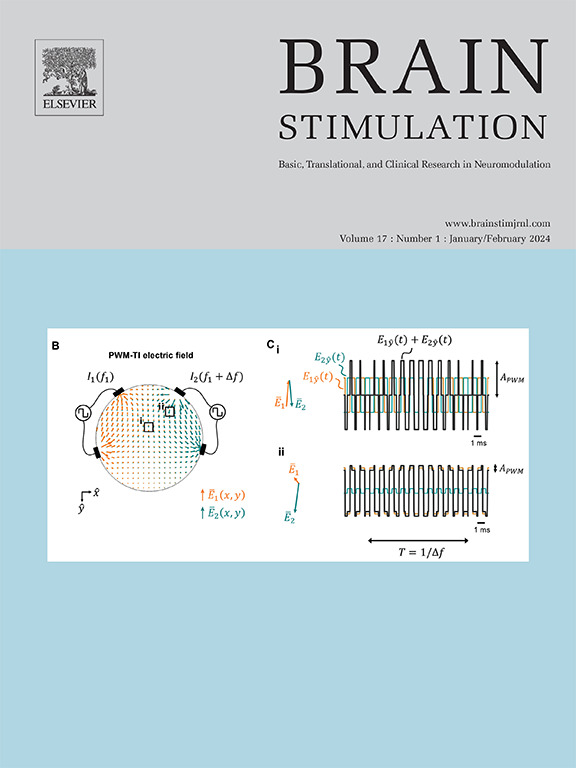大剂量和个性化TBS治疗脑卒中后认知障碍的疗效和安全性:一项随机对照试验。
IF 7.6
1区 医学
Q1 CLINICAL NEUROLOGY
引用次数: 0
摘要
背景:脑卒中患者普遍存在认知障碍,影响独立生活。虽然间歇性θ波爆发刺激(iTBS)显示出康复的潜力,但常用剂量的疗效仍不令人满意。目的:探讨针对个体化额顶叶认知网络(FCN)的大剂量iTBS对脑卒中后认知功能恢复的疗效、剂量依赖性和安全性。方法:在一项随机、假对照、三组试验中,卒中后认知障碍(PSCI)患者接受15天的高剂量(3600脉冲/天)、标准低剂量(1200脉冲/天)作为主动对照,或针对个体化FCN的假iTBS,同时进行认知训练。主要结果通过蒙特利尔认知评估(MoCA)测量全球认知的变化。次要测量包括MoCA反应率和韦氏记忆量表、韦氏成人智力量表和简易精神状态检查的得分变化。结果:在45名随机参与者中,41名(8名女性;平均[SD]年龄58.63[8.64]岁)。在E-field分析中,个性化目标比标准F3目标的焦点度提高了33.0%。高剂量组和标准低剂量组的MoCA均有显著改善。重要的是,高剂量组的认知恢复优于主动对照组(估计差异=2.50,p=0.0339, 95% CI=0.15-4.84)和假对照组(估计差异=4.29,p=0.0001, 95% CI=1.99-6.60),表明高剂量刺激对认知恢复的效果更佳。在其他次要结果中也观察到类似的高剂量和剂量依赖效应,表明对记忆、智力和精神状态有一致的影响。未发生严重不良事件。结论:本研究强调了针对个体化FCN的大剂量iTBS对脑卒中后认知恢复的有效性和安全性。本文章由计算机程序翻译,如有差异,请以英文原文为准。

Efficacy and safety of high-dose and personalized TBS on post-stroke cognitive impairment: A randomized controlled trial
Background
Cognitive impairments are prevalent among stroke patients, impacting independent living. While intermittent theta burst stimulation (iTBS) shows potential for rehabilitation, the efficacy of the commonly-used doses remains unsatisfactory.
Objective
To investigate the efficacy, dose-dependent effect, and safety of high-dose iTBS targeting the individualized frontoparietal cognitive network (FCN) for post-stroke cognitive recovery.
Methods
In a randomized, sham-controlled, three-arm trial, patients with post-stroke cognitive impairment (PSCI) received 15 days of high-dose (3600 pulses/day), standard low-dose (1200 pulses/day) as an active control, or sham iTBS targeting the individualized FCN, alongside cognitive training. Primary outcome measured changes in global cognition via the Montreal Cognitive Assessment (MoCA). Secondary measures included MoCA response rates and score changes in the Wechsler Memory Scale, Wechsler Adult Intelligence Scale, and Mini-Mental State Examination.
Results
Of forty-five randomized participants, forty-one (8 women; mean [SD] age, 58.63 [8.64] years) were analyzed. Personalized targeting improved focality by 33.0 % over the standard F3 target in E-field analysis. Both high-dose and standard low-dose groups showed significant improvements in MoCA. Importantly, the high-dose group demonstrated superior cognitive recovery over both the active control group (estimated difference = 2.50, p = 0.0339, 95 % CI = 0.15–4.84) and the sham control group (estimated difference = 4.29, p = 0.0001, 95 % CI = 1.99–6.60), indicating a superior effect of high-dose stimulation for cognitive recovery. Similar high-dose and dose-dependent effects were observed in other secondary outcomes, suggesting consistent effects on the memory, intelligence, and mental state. No serious adverse events occurred.
Conclusions
This study highlights the efficacy and safety of high-dose iTBS targeting the individualized FCN for post-stroke cognitive recovery.
求助全文
通过发布文献求助,成功后即可免费获取论文全文。
去求助
来源期刊

Brain Stimulation
医学-临床神经学
CiteScore
13.10
自引率
9.10%
发文量
256
审稿时长
72 days
期刊介绍:
Brain Stimulation publishes on the entire field of brain stimulation, including noninvasive and invasive techniques and technologies that alter brain function through the use of electrical, magnetic, radiowave, or focally targeted pharmacologic stimulation.
Brain Stimulation aims to be the premier journal for publication of original research in the field of neuromodulation. The journal includes: a) Original articles; b) Short Communications; c) Invited and original reviews; d) Technology and methodological perspectives (reviews of new devices, description of new methods, etc.); and e) Letters to the Editor. Special issues of the journal will be considered based on scientific merit.
 求助内容:
求助内容: 应助结果提醒方式:
应助结果提醒方式:


